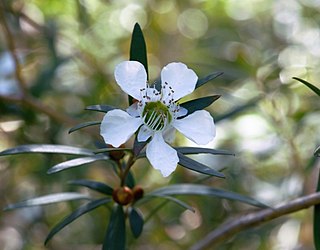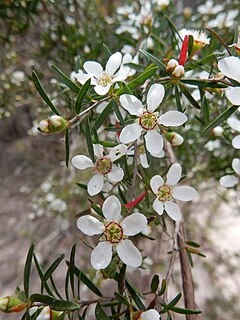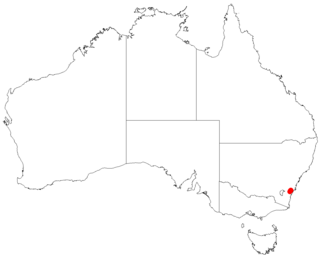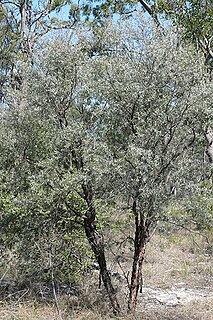
Leptospermum petersonii, commonly known as lemon-scented teatree, is a species of shrub or small tree that is endemic to eastern Australia. It has thin, fibrous or flaky bark, often strongly-scented elliptic to lance-shaped leaves, white flowers and fruit that are retained for several years. It is commonly grown as an ornamental and is regarded as a minor environmental weed in some areas.

Leptospermum squarrosum, commonly known as the peach blossom tea-tree, is an upright shrub of the family Myrtaceae and is endemic to central eastern New South Wales. It has thin, firm bark, broadly lance-shaped to elliptical leaves, relatively large white or pink flowers and fruit that remain on the plant when mature.

Leptospermum turbinatum, commonly known as shiny tea-tree, is a species of spreading shrub that is endemic to the Grampians and nearby ranges in Victoria, Australia. It has thin, rough bark, elliptical to lance-shaped leaves with the narrower end towards the base, relatively large white flowers and fruit that remains on the plant at maturity.

Leptospermum morrisonii is a shrub or small tree that is endemic to New South Wales. It has strongly aromatic, elliptical to lance-shaped or curved leaves, white or greenish white flowers and fruit that remain on the plant. It occurs in the south-east of the state.

Leptospermum obovatum, commonly known as river teatree, is a species of shrub that is endemic to south-eastern continental Australia. It has egg-shaped or lance-shaped leaves that are narrower at the base, white flowers usually arranged singly on short side shoots and fruit that remains on the plant until it dies.

Leptospermum exsertum is a small, sparsely branched shrub that is endemic to Western Australia. It has thick, wedge-shaped to heart-shaped leaves with the narrower end towards the base, often with a sharply pointed tip, white flowers arranged singly or in groups of up to three and fruit that falls off when mature.
Leptospermum sericeum, commonly known as the silver tea tree, is a species of shrub that is endemic to the south-west of Western Australia. It has thin, firm bark, egg-shaped leaves with the narrower end towards the base, relatively large, pink flowers and fruit that fall from the plant with the seeds. It grows in windswept rock crevices near Esperance.
Leptospermum subtenue is a species of small shrub in the family Myrtaceae and is endemic to Western Australia. It has thick, elliptical, concave leaves, white or pink flowers and fruit that falls from the plant when mature. It occurs to the south of Kalgoorlie.

Leptospermum coriaceum, commonly known as green tea-tree or mallee teatree, is a shrub species that is endemic to south-eastern Australia. It has smooth bark on the younger stems, elliptic to narrow egg-shaped leaves, white flowers and woody fruit. The usual habitat is mallee on sand dunes.

Leptospermum deanei, commonly known as Deane's tea-tree, is a species of rare, slender shrub that is endemic to the northern suburbs of Sydney. It has bark peeling in long strips from the older stems, hairy young stems, narrow elliptical to lance-shaped leaves, white flowers arranged singly on short side shoots and mostly glabrous fruit.

Leptospermum argenteum, commonly known as the Mt Royal tea-tree, is a species of shrub that is endemic to the higher parts of Barrington Tops in New South Wales. It has smooth bark, stems with a flange along the sides, broad leaves, white flowers and unlike many others in the genus, it is never lemon-scented.
Leptospermum benwellii is a species of shrub that is endemic to the Nymboida National Park in New South Wales. It has smooth bark, young branches with conspicuous flanges, narrow elliptical leaves, white flowers and thin-walled, bell-shaped to hemispherical fruit.

Leptospermum crassifolium is a species of shrub that is endemic to the Budawang Range in New South Wales. It has thin, rough bark that is shed annually, broadly elliptic leaves, white flowers borne singly on short side branches, and woody fruit.

Leptospermum lamellatum is a species of shrub or small tree that is endemic to inland Queensland and has distinctive reddish, layered bark. It has narrow elliptical leaves, white flowers and small fruit that fall from the plant when mature.

Leptospermum myrtifolium, commonly known as the myrtle tea-tree or grey tea-tree, is a species of shrub that is endemic to south eastern Australia. It has broad egg-shaped to elliptical leaves, white flowers usually borne singly on short side shoots, and fruit that remains on the plant until it dies.
Leptospermum polyanthum is a rigid, spreading shrub or small tree that is endemic to New South Wales. It has thin, rough bark, young stems that are hairy at first, elliptical leaves, relatively small white flowers and fruit are shed when the seeds are mature.

Leptospermum purpurascens, commonly known as the purple-stemmed turkey bush, is a shrub or small tree that is endemic to far north Queensland. It has bark that is purple when new, elliptical to broadly lance-shaped leaves, relatively small white flowers arranged in pairs and small fruit that falls from the plants when the seeds are released.
Leptospermum rupicola is a low-growing shrub that is endemic to New South Wales where it grows near cliffs. It has thin, rough bark, narrow lance-shaped leaves, white flowers and relatively large fruit that remain on the plant at maturity.

Leptospermum subglabratum is a species of open shrub that is endemic to a south-eastern New South Wales. It has thin, rough bark, egg-shaped to lance-shaped leaves with the narrower end towards the base, white flowers arranged singly on short side shoots and relatively small fruit that falls from the plant at maturity.

Leptospermum variabile is a species of shrub that is endemic to eastern Australia. It has thin, rough or scaly bark, broadly elliptical to lance-shaped leaves with the narrower end towards the base, white flowers arranged singly on the ends of short side branches, and woody fruit that remains on the plant when mature.
















